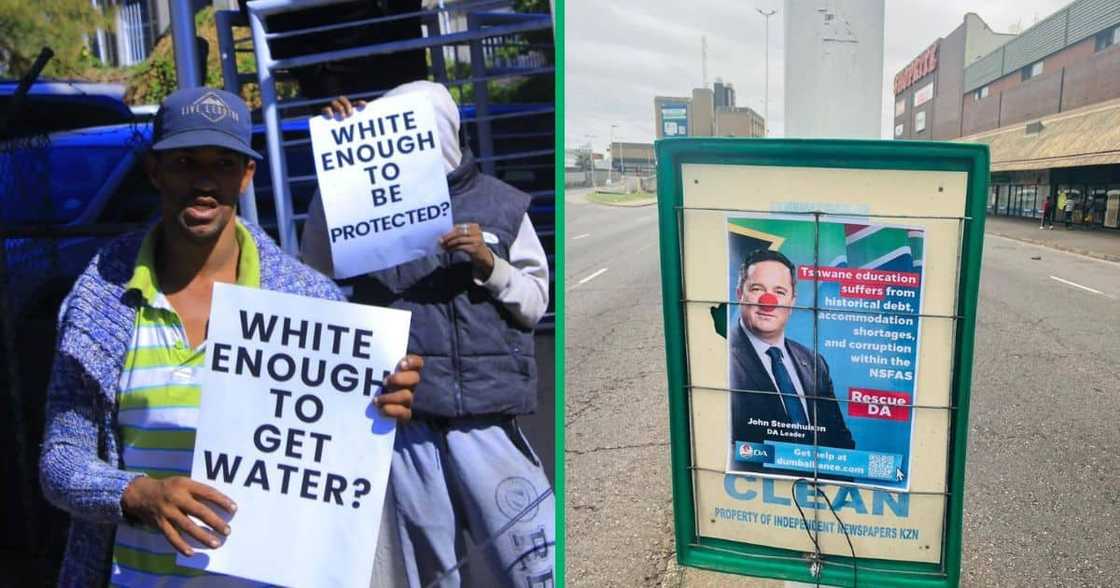Why Democratic Alliance Is Struggling With Public Perception
In recent times, the political landscape of South Africa has been stirring with the activities and campaigns of the Democratic Alliance (DA), particularly under the limelight of their RescueSA tour. The DA, striving to establish its prominence and governance ethos, has not been without criticism and public outcry, especially from those within its governance territories who grapple with issues that starkly contrast the party's promotional claims.

Source: UGC
At the heart of DA's stronghold, Cape Town, a city famed for its scenic vistas and vibrant culture, a discordant note is struck by the voices of the dissatisfied. Residents express deep-seated grievances, with complaints ranging from chronic water shortages to escalating crime rates, and, not least, a dearth of adequate housing. These issues lay bare the chasm between the DA's self-promotion and the stark realities faced by its constituents. For the people enduring these hardships daily, the promise of a 'rescue' seems distant, clouded by the immediate struggle for essential services and safety.
The narrative of dissatisfaction was dramatically underscored by a protest that unfolded outside the DA's offices in Cape Town. Here, the city's homeless, arguably the most marginalised and voiceless of any community, stood defiant.
With their faces painted and holding placards aloft, they presented a tableau of discontent. Their slogans, searing questions about racial equality in accessing basic amenities like water and security, echoed painfully through the streets. "Are we white enough to get water? Are we white enough to get protection?" they asked, pointing to systemic issues and perceptions of racial bias within the city's governance. This protest, however, culminated in their detention, a move that further embittered relations and raised questions about the DA's approach to civic engagement and protest.
As the DA's electoral campaigns gathered momentum, particularly in KwaZulu-Natal, the party's promotional efforts were met with a counter-wave of public opinion. In the city of eThekwini, this resistance was visually represented through posters adorning public spaces, which bore the images of DA leaders accompanied by critical captions. These posters highlighted the discontent simmering among the populace, contesting the DA's narrative.
The palpable divide between the party's representation and public perception reached a climax during John Steenhuisen's address. In a striking display of disapproval, people within the crowd brandished posters depicting Steenhuisen as a clown. This act of protest was not just a silent display of disagreement; it was a bold statement made in the face of the party leadership, embodying the collective disillusionment of those gathered. The hashtag #RescueDumbAlliance, which accompanied such demonstrations, became a symbol of derision, encapsulating the critical stance of the public towards the DA's promises and actions.
The hashtag itself, biting and irreverent, is a play on the party's RescueSA campaign, suggesting that it is the DA that requires rescuing from ineptitude or disconnect with the ground realities. The tag has found resonance across social media platforms, as netizens employ it to voice their cynicism and discontent with the party's governance and electioneering tactics.
It is safe to say that while the Democratic Alliance heralds its achievements and spreads its vision of prosperity under its governance, a contrasting narrative unfolds on the streets and homes of those it seeks to represent. People across regions other than the Cape openly display their reluctance, if not outright rejection, of the DA's influence in their locales.
Even within Cape Town, the supposed bastion of DA support, there is a growing sense of frustration and disillusionment. The stark dichotomy between the DA's self-promoted image and the lived experience of the citizenry stands as a testament to the complex and often turbulent nature of South African politics. The calls for rescue may indeed be for the party itself as it navigates the troubled waters of public opinion and the pressing demands of its constituents.
Written by Patrick Thurston
Source: Briefly News

